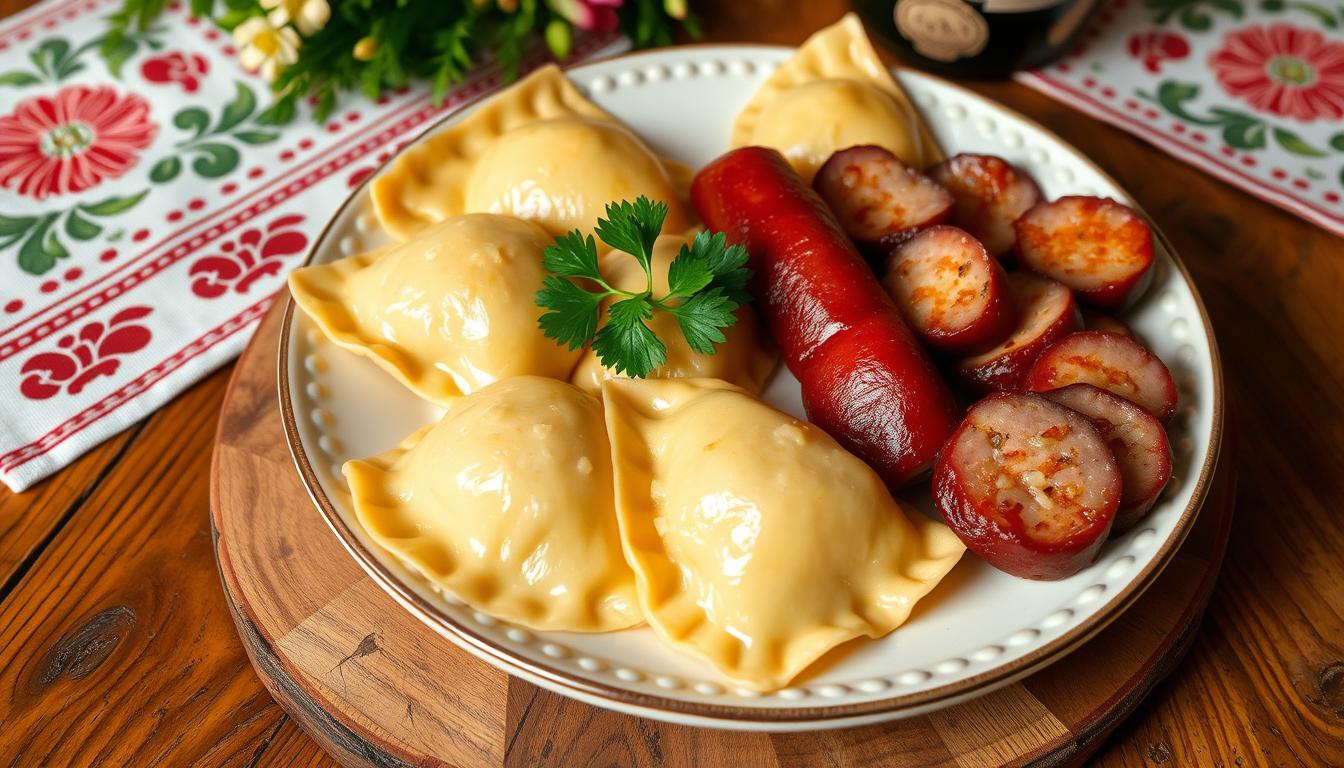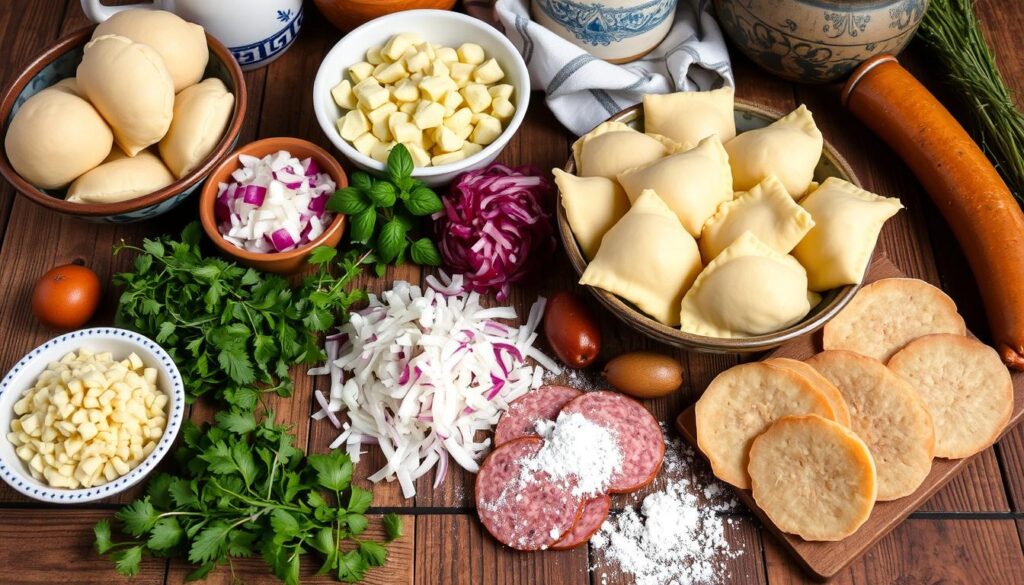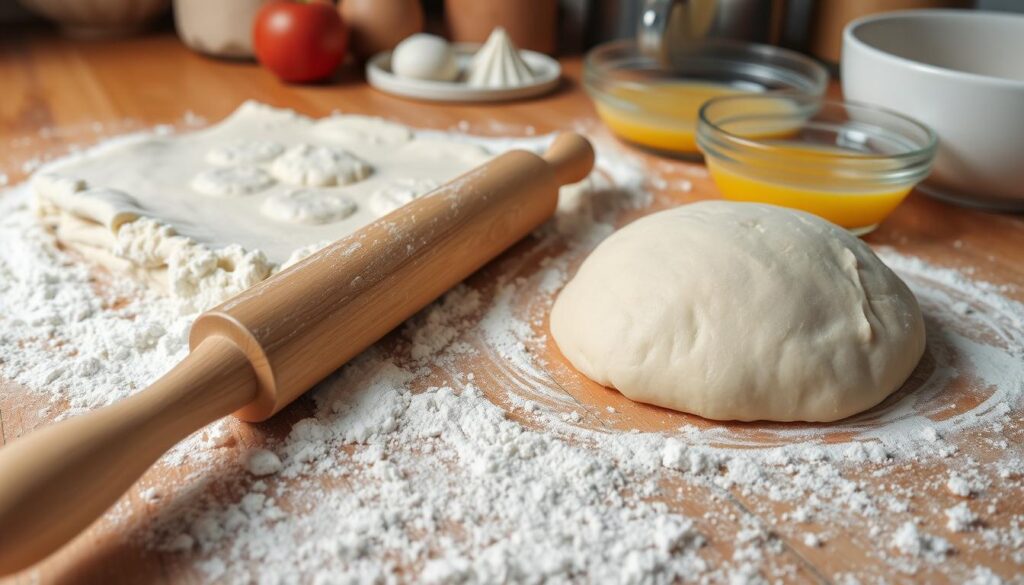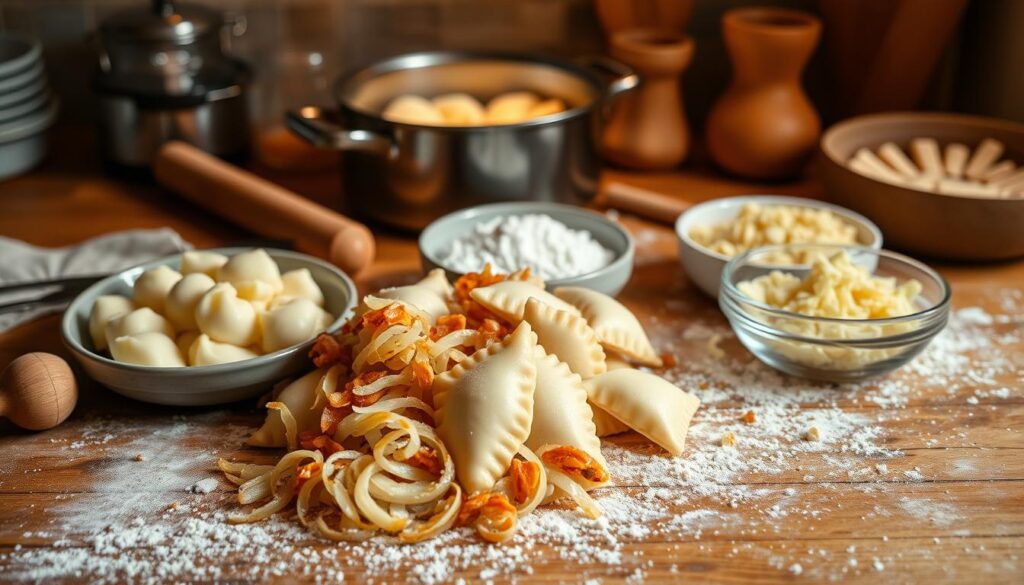Growing up in a Polish-American home, I saw pierogies and kielbasa as more than food. They were a link to our family’s past. Every Sunday, my grandmother would turn our kitchen into a cooking haven. The smell of Polish dishes filled our home.
Cooking pierogies and kielbasa is about keeping a family tradition alive. It’s for anyone who loves cooking or wants to try Polish dishes. This guide will help you make a dish that honors Poland’s rich flavors.
In just 25 minutes, you can make a tasty meal for 5 people. Each serving has 646 calories, with a good mix of protein, carbs, and nutrients. Get ready to enjoy a Polish meal at your dinner table.
Understanding Pierogies: A Brief Overview
Pierogies are a beloved part of Eastern European dishes. They show a rich culinary heritage that has won hearts around the world. These tasty dumplings give us a peek into traditional cooking methods that have been passed down for generations.
What Are Pierogies?
Pierogies are soft, delicate dumplings made from unleavened dough. They are filled with a variety of savory or sweet ingredients. Their versatility makes them a favorite comfort food in many cultures.
- Dough is made from flour, eggs, water, and salt
- Typically half-moon or crescent-shaped
- Can be boiled, pan-fried, or baked
The History of Pierogies
Pierogies come from Eastern Europe and have a rich history. Their exact origins are debated, but they are a key part of Polish, Ukrainian, and Russian cuisines for centuries.
“Pierogies are more than just food – they’re a cultural connection to our ancestors.” – Traditional Eastern European Cook
Common Fillings and Variations
The fillings of pierogies show the creativity of Eastern European cooks. From classic to new, these dumplings cater to all tastes.
| Filling Type | Popularity |
|---|---|
| Potato and Cheese | Most Common (70%) |
| Sauerkraut | Traditional Favorite (15%) |
| Mushroom | Vegetarian Option (10%) |
| Fruit | Sweet Variation (5%) |
Did you know that people usually eat five pierogies at a time? Most enjoy eight to ten in one sitting. Whether you love cooking or just want to try traditional dumplings, pierogies are a great way to explore Eastern European cuisine.
The Importance of Kielbasa in Polish Cuisine
Kielbasa is more than just a sausage in Polish cuisine. It’s a key part of their food traditions. These sausages hold the essence of Polish flavors that have been loved for generations.
Understanding Kielbasa’s Culinary Significance
Polish people eat a lot of sausages, about 20 kilograms each year. This shows how important kielbasa is in their diet. It’s a big part of their food culture.
- Kielbasa comes in multiple varieties
- Represents traditional cooking methods
- Reflects regional flavor profiles
Exploring Kielbasa Varieties
Kielbasa has many types, each with its own special taste. You can find smoked or fresh kielbasa, each with its own unique flavor.
| Kielbasa Type | Characteristics | Typical Usage |
|---|---|---|
| Biała | Fresh white sausage | Boiling, grilling |
| Kabanos | Thin, dry sausage | Snacking, appetizers |
| Wiejska | Rustic countryside style | Hearty meals |
Selecting Quality Kielbasa
When picking kielbasa, look for ones that are rich in color and firm. Authentic kielbasa should smell smoky and look natural. This shows it’s made the old way.
“Kielbasa is not just food, it’s a connection to Polish heritage and culinary tradition.”
Choosing the right kielbasa can make any meal special. It brings the taste of Polish kitchens right to your home.
Essential Ingredients for Pierogies and Kielbasa
Exploring Polish cuisine means learning about key ingredients. Making real pierogies and kielbasa needs specific parts. These parts bring out the deep flavors of Poland.
Ingredients for Homemade Pierogies
To make tasty pierogies, you need the right stuff. Your kitchen should have:
- 3 cups all-purpose flour
- 2 large eggs
- 1/2 cup warm water
- Pinch of salt
For the fillings, you’ll want:
- Potatoes
- Cheese
- Sauerkraut
- Onions
Essential Seasonings for Kielbasa
Kielbasa’s unique taste comes from special spices. Important seasonings are:
- Garlic powder
- Black pepper
- Marjoram
- Salt
Kitchen Equipment You’ll Need
For these Polish dishes, you’ll need certain tools:
| Equipment | Purpose |
|---|---|
| Rolling pin | Creating thin pierogi dough |
| Large mixing bowl | Preparing dough and fillings |
| Large pot | Boiling pierogies |
| Skillet | Frying kielbasa |
“The secret to great Polish cooking is in the details of ingredients and preparation.” – Polish Culinary Tradition
With these ingredients and tools, you’re set to make a true Polish meal. It will honor the rich food traditions of Poland.
Making Dough for Pierogies
Making the perfect dough is key to creating authentic dumplings. These traditional foods need precision and care. This makes pierogies so beloved.
Preparing pierogi dough is an art passed down through generations. The right technique turns simple ingredients into a delicious canvas for your favorite fillings.
Step-by-Step Dough Recipe
Your pierogi dough journey starts with these ingredients:
- 3 cups of Poznańska typ 500 flour
- 1 cup of hot water
- 1 tablespoon of butter or oil
Here’s how to make the perfect dough:
- Measure flour precisely into a large mixing bowl
- Create a well in the center of the flour
- Pour hot water gradually while mixing
- Knead until the dough becomes smooth and elastic
Tips for Perfect Dough Consistency
Mastering dough consistency is key to making great dumplings. Expert pierogi makers suggest these techniques:
| Technique | Purpose |
|---|---|
| Aerate flour | 20 seconds in food processor |
| Dough thickness | Roll thin for delicate texture |
| Resting time | Allow dough to relax before rolling |
“The secret is in the hands,” my grandmother would say, “Feel the dough, and it will tell you what it needs.”
Remember, practice makes perfect with these beloved traditional foods. Your first batch might not be flawless. But each attempt brings you closer to pierogi perfection.
Preparing Your Fillings for Pierogies
Exploring Polish cuisine means diving into comfort foods that warm the heart. Pierogies are a canvas for creative fillings, showing off regional delicacies from Poland.
When making pierogi fillings, picking the right ingredients is key. Polish cuisine celebrates simple yet flavorful mixes. These turn basic ingredients into amazing meals.
Popular Filling Options
Pierogi fillings range from classic to new. Here are some favorites:
- Classic potato and cheese
- Sauerkraut and mushroom
- Meat-based fillings
- Sweet fruit variations
Crafting the Perfect Mashed Potato Filling
Making a classic potato filling needs care. Start with:
- Boiling potatoes until tender
- Mashing thoroughly
- Adding salt and pepper
- Adding cheese for richness
Enhancing Fillings with Cheese and Other Ingredients
Cheese makes pierogies special. Think about adding:
| Cheese Type | Flavor Profile | Recommended Pairing |
|---|---|---|
| Farmer’s Cheese | Mild and creamy | Potato filling |
| Aged Cheddar | Sharp and tangy | Meat-based fillings |
| Smoked Gouda | Rich and smoky | Mushroom filling |
“The secret to great pierogies lies in the filling’s harmony of flavors” – Polish Culinary Tradition
Make sure to chop ingredients finely and seal pierogies well. This prevents filling leakage. Your effort will pay off with delicious Polish dishes.
Cooking Pierogies: Boiling vs. Frying
Learning to cook pierogies is all about mastering different techniques. Whether you like them boiled or fried, these methods will make your pierogies taste great every time.
Boiling Pierogies: The Traditional Method
Boiling is the traditional way to cook pierogies. Here’s how to do it right:
- Use at least 4 quarts of water to prevent overcrowding
- Bring water to a rolling boil
- Gently drop pierogies into boiling water
- Cook for approximately 3 minutes
- Remove when pierogies float to the surface
- Drain and rinse briefly with cold water
Frying for a Crispy Finish
For a crispy finish, fry your pierogies after boiling. Pro tip: Use 3 tablespoons of unsalted butter divided and 1 tablespoon of olive oil for a golden-brown look.
Final Touches After Cooking
Enhance your pierogies with classic toppings:
- Caramelize onions (takes 15-20 minutes over low heat)
- Add a dollop of sour cream
- Sprinkle fresh herbs for extra flavor
“The secret to perfect pierogies is in the cooking technique and final presentation.”
These pierogies are ready in just 30 minutes, perfect for a weeknight dinner. One bag can feed two people, with about 778 calories per serving.
Cooking Kielbasa: Best Methods
Exploring different cooking techniques for sausages can transform your culinary experience. Kielbasa, a traditional Polish sausage, offers versatile ethnic flavors. You can prepare it in many ways. Whether you’re a home cook or a food enthusiast, mastering these cooking approaches will elevate your kielbasa dishes.
Grilling Kielbasa for Maximum Flavor
Grilling brings out the rich, smoky characteristics of kielbasa. Preheat your grill to medium-high heat. Place the sausages directly on the grates. Cook for approximately 8-10 minutes, turning occasionally to ensure even charring and prevent burning. The high heat creates a delightful crispy exterior while maintaining the sausage’s juicy interior.
Sautéing Kielbasa: Quick and Easy Method
For a fast weeknight dinner, sautéing kielbasa is an excellent choice. Slice the sausage into medallions. Heat a skillet over medium heat. Add a tablespoon of oil and cook the pieces for 3-4 minutes per side until they develop a golden-brown color.
| Cooking Method | Cooking Time | Heat Level |
|---|---|---|
| Grilling | 8-10 minutes | Medium-High |
| Sautéing | 6-8 minutes | Medium |
| Baking | 20-30 minutes | 400°F |
Baking Kielbasa for Even Cooking
Baking provides a consistent cooking method with minimal effort. Preheat your oven to 400°F. Arrange kielbasa on a baking sheet. Bake for 20-30 minutes, turning once halfway through. This technique ensures uniform heating and helps render out excess fat.
“The key to perfect kielbasa is understanding how different cooking techniques impact its flavor and texture.” – Polish Culinary Experts
- Always check internal temperature (160°F for food safety)
- Let sausages rest for 3-5 minutes after cooking
- Experiment with marinades to enhance ethnic flavors
Serving Suggestions for Pierogies and Kielbasa
Polish cuisine is full of ethnic flavors that make simple foods into amazing meals. When you serve pierogies and kielbasa, try both old and new ways to enjoy them.
Classic Pairings that Delight
Traditional Polish cooking has special sides that make pierogies and kielbasa even better. Here are some classic ideas:
- Caramelized onions as a rich topping
- Fresh sour cream for creamy contrast
- Crispy bacon bits for added texture
- Sauerkraut as a tangy side dish
Creative Serving Ideas
Make your Polish dinner special by trying new ways to serve. Mix up these ethnic flavors in fun ways:
- Create a pierogi and kielbasa skillet
- Develop a hearty one-pan meal
- Slice kielbasa for a charcuterie board
- Use pierogies as appetizers with dipping sauces
Traditional Sauces and Condiments
Use real Polish condiments to bring out the flavors:
| Condiment | Pairing |
|---|---|
| Spicy Mustard | Kielbasa |
| Horseradish Cream | Pierogies |
| Dill Pickle Relish | Both Dishes |
“Food is our common ground, a universal experience.” – James Beard
Remember, serve 8-10 pierogies per person as a main dish. Each serving has about 241 calories. Start your culinary journey now!
Storing Leftovers: Pierogies and Kielbasa
Keeping your tasty culinary heritage fresh means knowing how to store leftovers. Pierogies and kielbasa are perfect examples. Learning how to store and reheat them lets you enjoy these dishes for days.
Storing Cooked Pierogies Safely
Homemade pierogies can stay fresh in the fridge for up to 4 days. Here’s how to keep them:
- Put pierogies in an airtight container
- Use parchment paper between layers to avoid sticking
- Keep the fridge at 40°F or below
Kielbasa Storage Guidelines
Kielbasa, a key Polish dish, needs careful storage to stay good:
- Put opened kielbasa in the fridge within 2 hours
- Use sealed containers or wrap tightly in plastic wrap
- Eat within 3-4 days for the best taste
Reheating Tips for Best Results
Reheating pierogies and kielbasa is easy with these steps:
- Microwave: Heat in 30-second bursts, stirring each time
- Skillet: Warm over medium heat with a bit of butter
- Oven: Reheat at 350°F for 10-15 minutes until warm
“Proper storage and reheating ensure your traditional foods taste just as delicious as when they were first prepared.” – Polish Cooking Expert
Conclusion: Enjoying Your Homemade Meal
Exploring Polish cuisine through homemade pierogies and kielbasa opens a delicious gateway to culinary heritage. Your kitchen becomes a canvas for creating authentic ethnic flavors. These flavors connect you with generations of traditional cooking.
Why Make Your Own Pierogies and Kielbasa
By preparing these dishes from scratch, you gain complete control over ingredients and flavor profiles. Whether you’re using a russet potato to fill 24 pierogies or selecting high-quality kielbasa, your personal touch transforms an ordinary meal into an extraordinary experience.
Final Thoughts on Quality Ingredients
Select fresh, premium ingredients to elevate your Polish cuisine. A single batch of pierogi dough requires just four basic ingredients: flour, salt, water, and vegetable oil. This simplicity allows you to focus on technique and authenticity while creating memorable meals.
Encouragement to Experiment with Recipes
Embrace your culinary creativity by trying different fillings, exploring variations, and adapting traditional recipes to suit your taste. Your homemade pierogies and kielbasa represent more than just a meal—they’re a celebration of cultural traditions and personal expression in the kitchen.
FAQ
What exactly are pierogies?
Pierogies are dumplings from Eastern Europe. They’re made from dough and filled with potatoes, cheese, or meat. They’re boiled or fried and served with onions or sour cream.
How difficult is it to make pierogies from scratch?
Making pierogies is a bit of a challenge but doable. It takes patience and practice. The key is getting the dough right and sealing it well to keep the filling inside.
What types of kielbasa are available?
There’s a lot of kielbasa out there. You can find smoked, fresh, and regional types. Some favorites include Krakowska, Wędzona, and Biała.
Can I freeze pierogies and kielbasa?
Yes, you can freeze both pierogies and kielbasa. Uncooked pierogies freeze well on a baking sheet. Cooked kielbasa can be frozen for months if wrapped right.
What are the best ways to cook kielbasa?
You can grill, pan-fry, bake, or simmer kielbasa. Each method brings out a different flavor.
Are pierogies gluten-free?
No, traditional pierogies have wheat flour, so they’re not gluten-free. But, you can make gluten-free versions with rice flour or special flour blends.
What traditional accompaniments go well with pierogies and kielbasa?
Sour cream, caramelized onions, and sauerkraut are great with pierogies and kielbasa. Polish families also like to add mustard, pickles, and fresh dill. Crusty bread or a green salad are nice sides too.
How long do homemade pierogies take to cook?
Boiling pierogies takes 3-5 minutes after they float. Pan-frying them for 2-3 minutes more makes them crispy.
Can I make vegetarian pierogies?
Yes! Vegetarian pierogi fillings are popular. You can use potatoes and cheese, sauerkraut, mushrooms, or spinach. They’re just as tasty as meat-filled ones.
What’s the difference between Polish and Ukrainian pierogies?
Polish and Ukrainian pierogies are similar but not the same. Ukrainian ones have thinner dough and different fillings. Polish pierogies have thicker dough and more fillings, showing local tastes.





